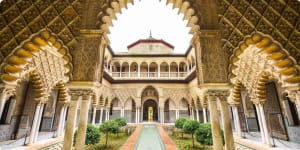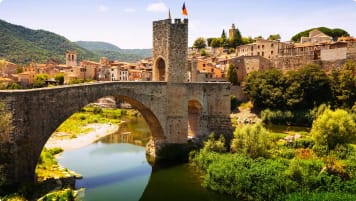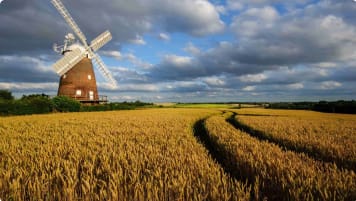Moors in Spain
A small group tour of Spain exploring Spain's Moorish past. Your tour leader discovers and traces of the art, architecture, and culture and religious reign and of the Moors in Spain visiting their key cities of Madrid, Toledo, Seville and the cities of Andalusia.
From A$15,875AUD

Highlights
- 1. Visit the Monasterio de San Juan de los Reyes in Toledo, its facade adorned by the shackles and manacles worn by the Christians taken prisoner by the Moors in Granada.
- 2. Walk through the ruins of UNESCO-listed Medina Azahara, an archaeological site of a vast, fortified city built in the 10th century to serve as the seat of the Caliphate of Cordoba.
- 3. Enter the Alcázar (fortress) of Seville, imbued with Moorish influences and the oldest royal palace still in use in Europe.
- 4. Shop at the La Alcaicería (Arab Spice Market), home of the Great Bazaar of Granada, where you can spend hours browsing the goods on sale.
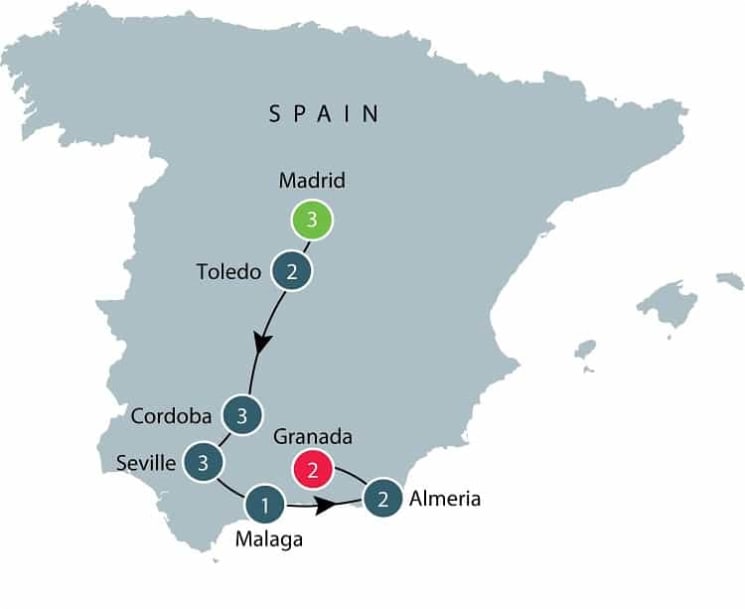
Departure Dates
| Departure Date | Price |
|---|---|
| 13 October 2025 Ends 29 October 2025 • 17 days A$15,875 Twin A$18,410 Single Available | Selected |
| 16 March 2026 Ends 01 April 2026 • 17 days A$16,275 Twin A$18,775 Single Available | |
| 12 October 2026 Ends 28 October 2026 • 17 days A$16,275 Twin A$18,775 Single Available | |
| 15 March 2027 Ends 31 March 2027 • days A$16,575 Twin A$19,150 Single Available | |
| 11 October 2027 Ends 27 October 2027 • days A$16,575 Twin A$19,150 Single Available |
Moors in Spain; Small group tour
Join Odyssey Traveller on this 20-day tour exploring Southern Spain's Moorish past. Together, led by your tour director, we will discover the traces of the art, moorish architecture, and religious reign and culture of the Moors in Spain by visiting their former strongholds in the Spanish capital of Madrid , before moving further south to Toledo in Castilla-La Mancha and several cities in the charming region of Andalusia with its spectacular landscapes. This seniors small group is part of a collection of Portugal and Spain tours offered each year.
Despite their fall and expulsion from the Iberian Peninsula during the Reconquista (Christian Reconquest) in the 15th century, the Moors in Spain have a long and riveting history. Their enduring influence on this Spain tour can be seen from the ruins of their citadels still standing on hilltops or the old town, to the grand bazaars that continue to lend colour and life to the Iberian peninsula, will provide us valuable insights about modern-day Spain as we head from central to Southern Spain and the Mediterranean.
This small group tour will be escorted by an Odyssey Program Leader, the tour director and a local tour guide who will impart their knowledge about the places we will visit. Odyssey Traveller has been serving global travellers since 1983, conducting educational tours with small groups of mature and senior travellers . Group size is typically between 6 to 12 people who are couples and solo travellers . The cost of the tour is inclusive of all entrances, tipping, and majority of the meals. On this tour we will dine in local restaurants and go on a wine tour to enjoy Spain's regional cuisines and rich wine culture.
This Small group tour of Spain links to the Morocco tour.
History of the Moors in Spain
Who were the Moors? Moor derives from the Latin Maurus, which the Romans used to denote the people of Mauretania (parts of present-day Algeria and Morocco). It later became applied to Arabs and Muslims living in Europe, and to the art, architecture, and culture of Muslim Andalusia and North Africa.
In 711, a group of Muslims from North Africa, led by the Berber general Tariq ibn-Ziyad, captured the Iberian Peninsula (present-day Spain and Portugal), which at the time was ruled first by the Romans, followed by the Visigoths under their Visigothic Kingdom of Hispania. The Berber forces were reinforced by the Arabs, and the strength of their combined forces led to the establishment of the independent Emirate of Cordoba ruled by the Umayyad dynasty, and the unification of the Muslim-ruled areas in the peninsula, now named Al-Andalus. (Cordoba is now part of the Spanish region of Andalusia in the south of the country).
Christian and Muslim forces fought in Europe for centuries, with the Islamic forces also dealing with internal conflicts due to ethnic clashes between the Berbers and Arabs. Traditional historiography states that the Christian victory at the Battle of Covadonga in the 8th century was the beginning of the Reconquista. The 11th century saw the disintegration of Cordoba and the beginning of the Crusades, which linked the fight on the Iberian peninsula with the wider fight of European Christendom.
The Moors' last stronghold in Spain was Granada, held by the Nasrid dynasty. After the fall of Cordoba in 1236, the Nasrids aligned themselves with Fernando III of Castile. However, in 1492, after months of war, Boabdil, the 22nd Nasrid ruler of Granada, surrendered complete control of the emirate to the Catholic monarchs, Ferdinand II of Aragon and Isabella I of Castile. This marked the completion of the Reconquista, and the end of the rule of Moors in Spain.
Highlights of the Tour
This tour will spend multiple nights in the following cities:
Madrid
Madrid developed as a medina (Arab town) in the 9th century, growing around the alcazar or castle overlooking the Manzanares River. It was mentioned in historical documents as “Majerit” in 932 AD when the Christian forces of Ramiro II of Leon attacked the city. It was eventually captured from the Muslims by Alfonso VI of Castile and Leon in 1083. Many kings spent time in this city, and in 1309, the Cortes, precursor to the Spanish Parliament, was first called in Madrid.
Madrid is a modern metropolis that has preserved its historic neighbourhoods and buildings, and will serve as the perfect gateway on our journey into Spain’s Moorish past. Among the places we will visit are:- Prado Museum - The Museo Nacional del Prado in Madrid opened to the public in 1819, starting with 1,510 paintings from the royal collection and which grew throughout the centuries.
- Royal Palace - which grew from a Moorish alcazar to the largest functioning royal palace in Europe. Sitting on 135,000 square metres with more than 3,000 rooms, the palace is now only used for official functions.
- Campo del Moro - "Moor's Field", where an Almoravid army laid siege to (and later retreated from) the city in the 12th century; this was transformed into a garden by Queen Maria Cristina in the 18th century. Located beneath the Royal Palace with Neoclassical fountains, the gardens offer exceptional views of the palace and a relaxing atmosphere.
- Arab City Walls - built in the 9th century, with ruins still visible in the modern city
Toledo
An hour south of Madrid, sitting atop a gorge overlooking the Tagus River, is the magnificent city of Toledo. Toledo is a medieval town that has been heavily influenced by its mix of Christian, Jewish and Muslim inhabitants throughout the centuries. The historic city of Toledo was designated a UNESCO World Heritage Site in 1986 for being ‘a repository of more than 2,000 years of history’.
Among the places we will visit are:- Monasterio de San Juan de los Reyes - a Franciscan monastery founded in the 15th century by King Ferdinand and Queen Isabella. Of interest are the shackles and manacles that adorn its facade; these were worn by the Christians taken prisoner by the Moors in Granada, and freed during the Reconquista. The shackles and manacles were added to the architecture by the order of the Queen.
- Sinagoga del Transito - a richly decorated synagogue built in 1355, years before the expulsion of the Jews from Spain in 1492. This features the Mudejar style (12th to 17th centuries) which was a blending of European Christian and Islamic influences in architecture in Spain.
- Alcazar of Toledo - from the Arab al-qasr or "fortress", built on the highest part of the city. This was renovated and rebuilt by the Christians. It was used as a royal palace by Charles I until the court moved to Madrid.
Cordoba
Cordoba was originally occupied by the Romans (152 BC) before being captured by the Muslims in 711. It became the Umayyad capital in 756 and grew rapidly, becoming the largest city in Europe by the 10th century. It eventually fell to Christian Spain in 1236, under the Castilian King Ferdinand. Our tour will give us glimpses of Cordoba's Moorish past, and the historic centre of the city which has been declared a UNESCO World Heritage Site in 1994.
We will visit:
- the Mezquita-Catedral de Córdoba (Mosque–Cathedral of Córdoba, the Grand Mosque), originally a mid-6th century Visigothic church turned into a mosque during Cordoba’s Islamic era. During the Reconquista, the Christian army entered Cordoba and celebrated the Holy Mass inside the mosque, converting the city and the mosque-cathedral back to the Catholic faith
- Alcazar of Cordoba, also known as Alcázar de los Reyes Cristianos, or "Castle of the Christian Monarchs". The Alcazar is located in the historic heart of the city, near the Grand Mosque. It has four towers, giving the fortress an almost square shape, and has a richly decorated interior with impressive mosaics.
- Medina Azahara, an archaeological site of a vast, fortified city built in the 10th century to serve as the seat of the Caliphate of Cordoba. This was inscribed as a UNESCO World Heritage Site in 2018. The city, complete with ceremonial halls, mosques, residences, a mint, and baths, was built on the orders of the first Umayyad Caliph of Cordoba, Abd-ar-Rahman III (912–961), to serve as a symbol of his and the Caliphate's power.
En route to Cordoba, we will visit La Bodega de las Estrellas, a traditional winery in Valdepeñas. Here we will enjoy a tour and a wine tasting. The grapes in La Bodega de las Estrellas are farmed organically and their wine-making is done naturally--a great introduction to Spain's rich wine culture.
Seville
Founded as the Roman city Hispalis and now the capital of the Andalusia region, Seville is a lively and disarming city, and a popular tourist destination in Spain.
Muslim possession of Seville ended with the Reconquista in 1248. The conquering Spanish Christians drove the Muslim and Jewish populations into exile, converting the synagogues and mosques into Catholic edifices. The first tribunal of the Spanish Inquisition was also held here in the 15th century. We will visit:
- The cathedral of Seville, the largest Gothic cathedral in the world with its Giralda Minaret standing at 96 meters. From this tower you can admire amazing views of the city. Once an Almohad mosque, it was turned into a Catholic Cathedral following the Reconquista in 1248 and now holds the remains of Juan of Aragon, son of Ferdinand and Isabella, and Christopher Columbus
- Barrio Santa Cruz - a "barrio" or neighbourhood where Seville's Jewish population was confined after the Reconquista; now a famous tourist destination, thanks to its picturesque alleys. It is the ultimate place where one can retrace the footprints of Jewish history in Spain
- The Alcázar (fortress) of Seville, imbued with Moorish influences, is the oldest royal palace still in use in Europe. The commission of a royal residence for King Pedro I in 1364 within the existing Moorish palace complex marked the beginning of the palace’s progressive reconstruction over the centuries that followed. It features a combination of Moorish, Mudejar, and European Renaissance and Baroque architectural and artistic elements.
Malaga
Malaga is the second-most-populous city in Andalusia after Seville. Founded by the Phoenicians, Malaga is considered one of the oldest city in Europe. It was under Islamic rule for 800 years, and we will be able to see the remnants of this long reign on our tour.
We will visit:
- Alcazaba de Málaga - from al-qasbah, "citadel"; this hilltop fortification is the best-preserved alcazaba in Spain, built in the 11th century, with the Moorish construction reusing the ruins of the original Roman fortification that stood in the area
- Castillo de Gibralfaro - situated above the Alcazaba, a fortress overlooking the city which originally served as a lighthouse and military barracks when Malaga was a port of the emirate of Granada
- Mercado de Atarazanas - Malaga's central market. The word atarazanas is Moorish in origin--"a place where ships are repaired"--as the location of the market used to be right at the sea's edge and was a shipyard in the 14th century.
Almeria
Almeria's name comes from al-Mariyyah, "the Watchtower", which is a reference to its Alcazaba or citadel. As part of the Caliphate of Cordoba, it grew prosperous in the 10th and 11th centuries, before falling to Christian forces in 1489.
- Alcazaba of Almeria - a fortified complex visible from any part of the city, and once the seat of the local government
- Castillo de San Cristobal - located near the Alcazaba and connected to it through walls
- Almeria Cathedral - a cathedral-fortress that is also known as the Cathedral of the Incarnation of Almería, built in Gothic and Renaissance styles
Granada
Located at the foot of the Sierra Nevada mountains, Granada was the last stronghold of the Moors in Spain. Moorish spirit and culture endure in the city today.
We will visit
- Granada's oldest centre of Muslim culture, the Albaicín (Albayzin), a UNESCO World Heritage Site. Albaicín retains the narrow winding streets dating back from its medieval Moorish era, and a brilliant place to begin our Moorish journey in Granada.
- La Alcaicería (Arab Spice Market) - home of the Great Bazaar of Granada, where you can spend hours browsing the goods on sale. Alcaicería, from the Arabic al-Kaysar-ia ("the place of Caesar"), refers to the time the Byzantine Emperor Justinian granted Arabs the exclusive right to manufacture and sell silk. This particular Alcaicería was built in the 15th century and was once home to more than 200 shops squeezed together in the narrow streets
- Capilla Real (Royal Chapel of Granada) - originally integrated with the Granada Cathedral, housing the tombs of Ferdinand and Isabella
- Alhambra and Generalife - Alhambra is the Arab citadel and palace, originally constructed in the 9th century upon Roman ruins, and the Generalife gardens (entry subject to availability) was once the summer palace and estate of the Nasrid rulers of Granada. Both are UNESCO World Heritage Sites, key to understanding Granada's Moorish past.
For more details, click the ‘Top 5’ or ‘Itinerary’ buttons above! If you’re keen to experience this tour, please call or send an email. Or, to book, simply fill in the form on the right hand side of this page.
Articles by Odyssey Traveller to help prepare for this Spain Small Group Tour for Seniors
The following list of articles published by Odyssey Traveller for mature aged and senior travellers to maximise their knowledge and enjoyment of Spain when visiting;
- Questions About Spain
- 15 of the best places in Spain to visit.
- Travel notes for Barcelona
- Ten of the best books published on Spain
- Ten of the Best art galleries in Europe to visit.
- Discovering Spain (and Portugal )
External articles to assist you on your visit to Spain
- Royal Palace
- History of Madrid
- History of Seville
- Spain's New World Heritage Site Is Putting Its Moorish History on the Map
- What Was Europe Like Under Moorish Rule?
- Who Were the Moors?
- Moor (definition)
Other Odyssey Tours
This is only one of many Spain and Portugal tours offered by Odyssey Traveller. Click the links to see our other tours to the Iberian Peninsula for mature and senior travellers.
Gallery
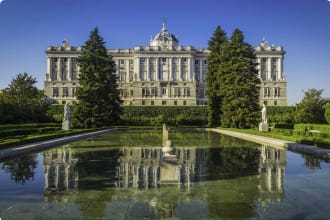
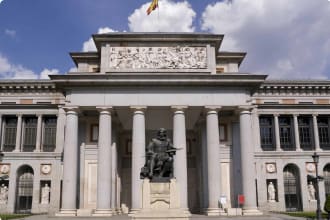


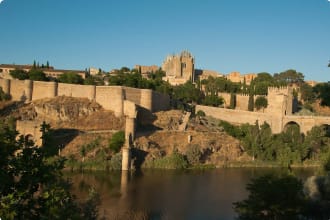
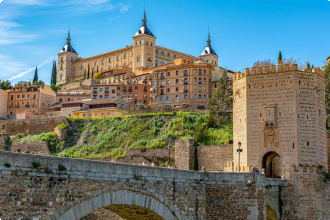
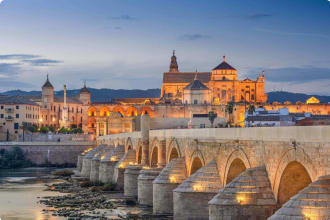
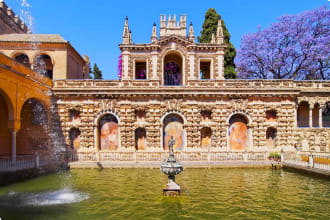
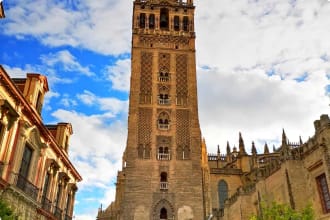
Itinerary
17 days
Day 1: Madrid
Accommodation: Quatro Puerta del Sol or similar
We arrive in Madrid and make our own way to our hotel. The remainder of the day is free, until we meet again in the evening with the Odyssey Program Leader for our Welcome Dinner. (D)
Day 2: Madrid
Accommodation: Quatro Puerta del Sol or similar
Today we will go on a full-day city tour of Madrid. Madrid is a modern metropolis that has preserved its historic neighbourhoods and buildings, and will serve as the perfect gateway on our journey into Spain’s Moorish past. Among the places we will visit today are:
- Plaza Mayor – a major public square in the heart of Madrid
- Prado Museum – The Museo Nacional del Prado in Madrid opened to the public in 1819, starting with 1,510 paintings from the royal collection and which grew throughout the centuries. Highlights include The Garden of Earthly Delights by Bosch, The Nobleman with his hand on his Chest by El Greco, Self-portrait by Dürer and The Family of Carlos IV by Goya.
- Royal Palace – which grew from a Moorish alcazar to the largest functioning royal palace in Europe. Sitting on 135,000 square metres with more than 3,000 rooms, the palace is now only used for official functions. The royal family now resides in the more modest La Zarzuela Palace northwest of Madrid. The Royal Palace is open to the public and is worth a visit for its interior filled with paintings and beautiful décor.
- Campo del Moro – “Moor’s Field”, where an Almoravid army laid siege to (and later retreated from) the city in the 12th century; this was transformed into a garden by Queen Maria Cristina in the 18th century. Located beneath the Royal Palace with Neoclassical fountains, the gardens offer exceptional views of the palace and a relaxing atmosphere.
- Arab City Walls – built in the 9th century, with ruins still visible in the modern city
(B)
Day 3: Madrid - San Lorenzo Escorial - Madrid
Accommodation: Quatro Puerta del Sol or similar
Today we will head out of Madrid to visit the Royal Site of San Lorenzo de El Escorial (Monasterio del Escorial), a UNESCO World Heritage Site located at the foot of Mt Abantos. This historical royal palace was expanded under Philip II, who engaged architect Juan Bautista de Toledo, who also worked on St Peter’s Basilica. The Royal Site’s Hall of Battles are decorated with fresco paintings that depict the most important Spanish military victories, including their victory over the Moors. We will return to Madrid and have the afternoon free to spend at our leisure. (B)
Day 4: Madrid - Toledo
Accommodation: Hotel Sercotel Alfonso VI or similar
Today we will travel to Toledo, a city heavily influenced by the Moors. Often called ‘Imperial City’ because it was the main venue of the court of Charles V, Holy Roman Emperor in Spain, Toledo is a medieval town that has been heavily influenced by its mix of Christian, Jewish and Muslim inhabitants throughout the centuries. You will find monuments scattered throughout the city that reflect Toledo’s ‘three cultures’ and many of the city’s most visited attractions are religious. The historic city of Toledo was designated a UNESCO World Heritage Site in 1986 for being ‘a repository of more than 2,000 years of history’ and for its architectural masterpieces that hold such importance for Christians, Muslims and Jews. Among the places we will visit are:
- Monasterio de San Juan de los Reyes – a Franciscan monastery founded in the 15th century by King Ferdinand and Queen Isabella. Of interest are the shackles and manacles that adorn its facade; these were worn by the Christians taken prisoner by the Moors in Granada, and freed during the Reconquista (Reconquest). The shackles and manacles were added to the architecture by the order of the Queen.
- Sinagoga del Transito – a richly decorated synagogue built in 1355, years before the expulsion of the Jews from Spain in 1492. Today it houses the Sephardic Museum which looks at the history of Jewish culture in the country. This features the Mudejar style (12th to 17th centuries) which was a blending of European Christian and Islamic influences in architecture in Spain.
- Synagogue of Santa Maria la Blanca – a former synagogue converted into a museum now owned by the Catholic Church; a fine example of Almohad-era Moorish Architecture.
We will have dinner at a local restaurant before turning in for the night. (B, D)
Day 5: Toledo
Accommodation: Hotel Sercotel Alfonso VI or similar
Having settled in the city, we will now enjoy a full-day guided tour of Toledo. We will visit:
- Museo de Santa Cruz – originally a 16th century hospital, transformed into an arts and ceramics museum in the 19th century; it has Mudejar-style ceilings and an incredible Plateresque facade. Plateresque (“in the manner of a silversmith”, with plata meaning “silver”) developed in the 15th century and blends Mudejar and Gothic elements. It has an exhibit dedicated to Moorish culture.
- Mosque of Cristo de la Luz – a well-preserved former mosque dating from the city’s Moorish period
- Alcazar of Toledo – from al-qasr or “fortress”, built by Abd ar-Rahman III in the 10th century on the highest part of the city. This was renovated and rebuilt by the Christians. It was used as a royal palace by Charles I for a time but once the court moved to Madrid, it became a military academy. The Alcazar was besieged and heavily damaged during the Spanish Civil War. Archaeological remains from the Moorish times are still visible here.
- Muralla de Toledo – originally built by the Romans and Visigoths, the city walls, visible from a distance, were enlarged by the Moors, who also enlarged the city
- Puente de Alcantara – or Alcantara Bridge, spanning the Tagus River
(B)
Day 6: Toledo - Valdepeñas - Cordoba
Accommodation: Macia Alfaros or similar
Today we will make our way south to Cordoba in Andalucia. En route, we will stop at La Bodega de las Estrellas, a traditional winery in Valdepeñas. Here we will enjoy a tour and a wine tasting. The grapes in La Bodega de las Estrellas are farmed organically and their wine-making is done naturally–a great introduction to Spain’s rich wine culture. We will have our dinner in Cordoba. (B, D)
Day 7: Cordoba
Accommodation: Macia Alfaros or similar
Today we will have a full-day guided tour of Cordoba. Cordoba was originally occupied by the Romans (152 BC) before being captured by the Muslims in 711. It became the Umayyad capital in 756 and grew rapidly, becoming the largest city in Europe by the 10th century. It eventually fell to Christian Spain in 1236, under the Castilian King Ferdinand. Our tour will give us glimpses of Cordoba’s Moorish past, and the historic centre of the city which has been declared a UNESCO World Heritage Site in 1994. We will visit:
- the Mezquita-Catedral de Córdoba (Mosque–Cathedral of Córdoba, the Grand Mosque), originally a mid-6th century Visigothic church turned into a mosque during Cordoba’s Islamic era. During the Reconquista, the Christian army entered Cordoba and celebrated the Holy Mass inside the mosque, converting the city and the mosque-cathedral back to the Catholic faith.
- Roman bridge of Cordoba – spanning the Guadalquivir river; though originally Roman, the present structure dates from the Moorish era in the 8th century
- Museo Arqueológico de Córdoba – Archeology Museum of Cordoba, housing archaeological artefacts from prehistory to the Middle Ages, including a fine collection of Moorish art
(B)
Day 8: Cordoba
Accommodation: Macia Alfaros or similar
This morning we will have a guided tour of the Alcazar of Cordoba, also known as Alcázar de los Reyes Cristianos, or “Castle of the Christian Monarchs”. The Alcazar is located in the historic heart of the city, near the Grand Mosque which we have visited on Day 7. It has four towers, giving the fortress an almost square shape, and has a richly decorated interior with impressive mosaics. The afternoon can be spent at leisure. (B)
Day 9: Cordoba - Seville
Accommodation: Becquer Hotel or similar
Today we will visit the Medina Azahara, an archaeological site of a vast, fortified city built in the 10th century to serve as the seat of the Caliphate of Cordoba. This was inscribed as a UNESCO World Heritage Site in 2018. The city, complete with ceremonial halls, mosques, residences, a mint, and baths, was built on the orders of the first Umayyad Caliph of Cordoba, Abd-ar-Rahman III (912–961), to serve as a symbol of his and the Caliphate’s power. After our visit, we continue to Seville. (B)
Day 10: Seville
Accommodation: Becquer Hotel or similar
The capital of the Andalusia region, Seville is a lively and disarming city, and a popular tourist destination in Spain. Seville was founded by the Romans as the city Hispalis. It flourished from the 2nd century AD as an administrative centre of the prosperous province of Baetica, before passing into the hands of the Visigoths. It was captured by the Moors in the 8th century and served as capital for the kings of the Umayyad Caliphate. Traces of their rule can still be seen in the surviving monuments of modern-day Seville, though some designs belong to the Arab-inspired Mudejar aesthetic, which actually developed during Christian rule. On our guided tour of Seville, we will see:
- the grand Plaza de Espana, built in 1928 in the Neo-Mudejar style
- The cathedral of Seville, the largest Gothic cathedral in the world with its Giralda Minaret standing at 96 meters. From this tower you can admire amazing views of the city. It was begun in 1401 and took more than a century to complete. Once an Almohad mosque, it was turned into a Catholic Cathedral following the Reconquista in 1248 and now holds the remains of Juan of Aragon, son of Ferdinand and Isabella, and Christopher Columbus
- Barrio Santa Cruz – a “barrio” or neighbourhood where Seville’s Jewish population was confined after the Reconquista; now a famous tourist destination, thanks to its picturesque alleys. It is the ultimate place where one can retrace the footprints of Jewish history in Spain.
- Casa de Pilatos (Pilate’s House) – an Italian Renaissance building mixed with Mudejar elements, and which serves as the residence of the Dukes of Medinaceli.
(B)
Day 11: Seville
Accommodation: Becquer Hotel or similar
Today we will be visiting the world-famous Alcazar of Seville. The Alcázar (fortress) of Seville, imbued with Moorish influences, is the oldest royal palace still in use in Europe. The commission of a royal residence for King Pedro I in 1364 within the existing Moorish palace complex marked the beginning of the palace’s progressive reconstruction over the centuries that followed. A combination of Moorish, Mudejar, and European Renaissance and Baroque architectural and artistic elements, in addition to the palace gardens, water channels and fountains ,gives the whole structure a magical air and offers an insight into the history and culture of Seville. The afternoon is free, though the group may consider visiting Barrio de Triana to visit the ceramic workshops. The workshops are especially renowned for their fine azulejos, glazed ceramic tiles adorned with colourful geometric patterns—a legacy of Andalusia’s Moorish aesthetic.
Day 12: Seville - Malaga
Accommodation: Malaga Premium Hotel or similar
Today we will be travelling to Malaga, the second-most-populous city in Andalusia after Seville. Founded by the Phoenicians, Malaga is considered one of the oldest city in Europe. It was under Islamic rule for 800 years, and we will be able to see the remnants of this long reign on our tour. We will visit:
- Alcazaba de Málaga – from al-qasbah, “citadel”; this hilltop fortification is the best-preserved alcazaba in Spain, built in the 11th century, with the Moorish construction reusing the ruins of the original Roman fortification that stood in the area
- Castillo de Gibralfaro – situated above the Alcazaba, a fortress overlooking the city which originally served as a lighthouse and military barracks when Malaga was a port of the emirate of Granada
- Mercado de Atarazanas – Malaga’s central market. The word atarazanas is Moorish in origin—“a place where ships are repaired”–as the location of the market used to be right at the sea’s edge and was in fact a shipyard in the 14th century. Within the market is a building that incorporates an original Moorish arch. (The market is open from Monday to Saturday, from 8 am to 2 pm.)
Day 13: Malaga - Almeria
Accommodation: AC Hotel Almeria or similar
We will have the morning free to spend at our leisure–if perhaps you would want to return to the market or walk around the city at your own pace. In the afternoon we will head to Almeria, where we will have dinner and rest in our hotel. (B, D)
Day 14: Almeria
Accommodation: AC Hotel Almeria or similar
Almeria’s name comes from al-Mariyyah, “the Watchtower”, which is a reference to its Alcazaba or citadel. As part of the Caliphate of Cordoba, it grew prosperous in the 10th and 11th centuries, before falling to Christian forces in 1489.
- Alcazaba of Almeria – a fortified complex visible from any part of the city, and once the seat of the local government
- Castillo de San Cristobal – located near the Alcazaba and connected to it through walls
- Almeria Cathedral – a cathedral-fortress that is also known as the Cathedral of the Incarnation of Almería, built in Gothic and Renaissance styles
Our afternoon is at leisure. (B)
Day 15: Almeria - Granada
Accommodation: Hotel Barcelo Carmen or similar
Today we will be travelling to Granada and enjoy an afternoon guided tour. Located at the foot of the Sierra Nevada mountains, Granada was the last stronghold of the Moors in Spain. The city began its life as an Iberian settlement that was taken over from the Visigoths in 711 during the Umayyad conquest of Hispania, also known as the Muslim Conquest of the Iberian Peninsula. The name Granada comes from the Arabic word Gárnata (or Karnatah), meaning “hill of strangers”. Moorish spirit and culture endures in the city today. This afternoon, accompanied by our local guide, we will walk through Granada’s oldest centre of Muslim culture, the Albaicín (Albayzin), a UNESCO World Heritage Site. Albaicín retains the narrow winding streets dating back from its medieval Moorish era, and a brilliant place to begin our Moorish journey in Granada. We will also visit the Church of San Salvador, also called the Colegiata (or school) of San Salvador, as it was originally built at a former mosque to teach Christianity to the Moors following the Christian conquest of 1492. We will also enter El Bañuelo, impressive and well-preserved Arab baths dating from the 11th century, and currently located at the bottom of a private home. (B)
Day 16: Granada
Accommodation: Hotel Barcelo Carmen or similar
Yesterday was just a taste of Granada, as today we will enjoy a full-day tour of this charming city. We will visit:
- La Alcaicería (Arab Spice Market) – home of the Great Bazaar of Granada, where you can spend hours browsing the goods on sale. This bazaar has a long history. Alcaicería, from the Arabic al-Kaysar-ia (“the place of Caesar”), refers to the time Emperor Justinian granted Arabs the exclusive right to manufacture and sell silk. This particular Alcaicería was built in the 15th century and was once home to more than 200 shops squeezed together in the narrow streets
- Cathedral Santa María de la Encarnación – or the Granada Cathedral, a Gothic marvel
- Capilla Real (Royal Chapel of Granada) – originally integrated with the Granada Cathedral, housing the tombs of Ferdinand and Isabella
- Alhambra and Generalife – Alhambra is the Arab citadel and palace, originally constructed in the 9th century upon Roman ruins, and the Generalife gardens (entry subject to availability) was once the summer palace and estate of the Nasrid rulers of Granada. Both are UNESCO World Heritage Sites, key to understanding Granada’s Moorish past.
We will have dinner at a local restaurant. (B, D)
Day 17: Granada
Our tour and services end after breakfast. (B)
Includes / Excludes
What’s included in our Tour
- 16 nights of hotel accommodation.
- 16 breakfasts and 7 dinners.
- Applicable entry fees and services of local guides.
- Touring by comfortable and modern coach.
- Field trips as indicated.
- Gratuities and necessary tips.
- Services of an Odyssey program leader.
- Detailed tour information booklet.
What’s not included in our Tour
- Return international airfare and departure taxes.
- Comprehensive international travel insurance.
- Items of a personal nature such as telephone calls and laundry.
- Meals not specified in the itinerary.
Participants must be able to carry their own luggage, climb and descend stairs, be in good health, mobile and able to participate in 3-5 hours of physical activity per day, the equivalent of walking / hiking up to 8 kilometers per day on uneven ground.
Book now
Make it a private tour
Easing your journey
Crossing international borders with restrictions
The list of requirements to travel internationally has changed and will continue to change for several years. Odyssey is here to assist you in managing your way through these requirements:
For more information see our Crossing international borders with restrictions page.
Book With Confidence
If less than 30 days before your tour starts you are unable to travel as a result of Government travel restrictions, Odyssey Traveller will assist you with a date change, provide you with a credit or process a refund for your booking less any non-recoverable costs.
See Terms and conditions for details.
Peace of Mind Travel
The safety of our travellers, tour leader, local guide and support staff has always been our top priority and with the new guidelines for public health and safety for keeping safe for destinations around the world, we’ve developed our plan to give you peace of mind when travelling with us.
See Peace of Mind Travel for details.
Reading List Download PDF
The Moors in Spain
Stanley Lane-Poole
The history of Spain offers us a melancholy contrast. Twelve hundred years ago, Tarik the Moor added the land of the Visigoths to the long catalogue of kingdoms subdued by the Moslems. For nearly eight centuries, under her Mohammedan rulers, Spain set to all Europe a shining example of a civilized and enlightened State. Her fertile provinces, rendered doubly prolific by the industry and engineering skill of her conquerors, bore fruit an hundredfold.
The Moors in Spain
M. Florian
This is a comprehensive history of the Moors, who were part of the Muslim empire and held territory in the Iberian peninsula for centuries until Ferdinand & Isabella were able to defeat them at the end of the 15th century.
Tales of the Alhambra
Washington Irving
Tales of the Alhambra is must-reading for the traveler in Spain and the best souvenir of your visit.
Irving is best remembered in this country for his collections of American folklore, like the stories of Rip Van Winkle and the Headless Horseman, but in Spain they remember him for the Alhambra stories. Irving lived in the old Moorish palace at a time when it was a neglected ruin, and his wonderful descriptions, interspersed with the folk-tales that he collected from the people of Granada, helped to spark interest in repairing and restoring the monument.
The folk tales, told in Irving's inimitable, witty style, usually deal with romantic elopements, or buried treasure, or both. Fantasy, history and folklore come together in this beautiful collection
The Moor's Last Stand: How Seven Centuries of Muslim Rule in Spain Came to an End
Elizabeth Drayson
In 1482, Abu Abdallah Muhammad XI became the twenty-third Muslim King of Granada. He would be the last. This is the first history of the ruler, known as Boabdil, whose disastrous reign and bitter defeat brought seven centuries of Moorish Spain to an end. It is an action-packed story of intrigue, treachery, cruelty, cunning, courtliness, bravery and tragedy.
Basing her vivid account on original documents and sources, Elizabeth Drayson traces the origins and development of Islamic Spain. She describes the thirteenth-century founding of the Nasrid dynasty, the cultured and stable society it created, and the feuding which threatened it and had all but destroyed it by 1482, when Boabdil seized the throne. The new Sultan faced betrayals by his family, factions in the Alhambra palace, and ever more powerful onslaughts from the forces of Ferdinand and Isabella, monarchs of the newly united kingdoms of Castile and Aragon.
By stratagem, diplomacy, courage and strength of will Boabdil prolonged his reign for ten years, but he never had much chance of survival. In 1492 Ferdinand and Isabella, magnificently attired in Moorish costume, entered Granada and took possession of the city. Boabdil went into exile. The Christian reconquest of Spain, that has reverberated so powerfully down the centuries, was complete.
Blood and Faith: The Purging of Muslim Spain, 1492-1614
Matt Carr
In 1609, the entire Muslim population of Spain was given three days to leave Spanish territory or else be killed. In a brutal and traumatic exodus, entire families were forced to abandon the homes and villages where they had lived for generations. In just five years, Muslim Spain had effectively ceased to exist: an estimated 300,000 Muslims had been removed from Spanish territory making it what was then the largest act of ethnic cleansing in European history.Blood and Faith is a riveting chronicle of this virtually unknown episode, set against the vivid historical backdrop of Muslim Spain. It offers a remarkable window onto a little-known period in modern Europe-a rich and complex tale of competing faiths and beliefs, of cultural oppression and resistance against overwhelming odds.
Muslim Spain and Portugal: A Political History of al-Andalus
Hugh Kennedy
This is the first study in English of the political history of Muslim Spain and Portugal, based on Arab sources. It provides comprehensive coverage of events across the whole of the region from 711 to the fall of Granada in 1492. Up till now the history of this region has been badly neglected in comparison with studies of other states in medieval Europe. When considered at all, it has been largely written from Christian sources and seen in terms of the Christian Reconquest. Hugh Kennedy raises the profile of this important area, bringing the subject alive with vivid translations from Arab sources. This will be fascinating reading for historians of medieval Europe and for historians of the middle east drawing out the similarities and contrasts with other areas of the Muslim world.
